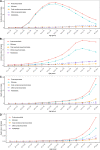The burden of pneumoconiosis in China: an analysis from the Global Burden of Disease Study 2019
- PMID: 35659279
- PMCID: PMC9166455
- DOI: 10.1186/s12889-022-13541-x
The burden of pneumoconiosis in China: an analysis from the Global Burden of Disease Study 2019
Abstract
Background: Pneumoconiosis refers to a class of serious diseases threatening the health of workers exposed to coal or silicosis dust. However, the burden of pneumoconiosis is unavailable in China.
Methods: Incident cases, deaths, and disability-adjusted life years (DALYs) from pneumoconiosis and its subtypes in China were estimated from the Global Burden of Disease Study 2019 using a Bayesian meta-regression method. The trend of the burden from pneumoconiosis was analyzed using percentage change and annualized rate of change (ARC) during the period 1990-2019. The relationship between subnational socio-demographic index (SDI) and the ARC of age-standardised death rate was measured using Spearman's Rank-Order Correlation.
Results: In 2019, there were 136.8 (95% uncertainty interval [UI] 113.7-162.5) thousand new cases, 10.2 (8.1-13.6) thousand deaths, and 608.7 (473.6-779.4) thousand DALYs from pneumoconiosis in China. Of the global burdens from pneumoconiosis, more than 60% were in China. Both the total number of new cases and DALYs from pneumoconiosis was keeping increasing from 1990 to 2019. In contrast, the age-standardised incidence, death, and DALY rates from pneumoconiosis and its subtypes, except for the age-standardised incidence rate of silicosis, and age-standardised death rate of asbestosis, experienced a significant decline during the same period. The subnational age-standardised death rates were higher in western China than in eastern China. Meanwhile, the subnational ARC of age-standardised death rates due to pneumoconiosis and its subtypes were significantly negatively correlated with SDI in 2019.
Conclusion: China suffers the largest health loss from pneumoconiosis in the world. Reducing the burden of pneumoconiosis is still an urgent task in China.
Keywords: DALY; Death; Disease burden; Pneumoconiosis; Silicosis.
© 2022. The Author(s).
Conflict of interest statement
The authors declare that they have no competing interests.
Figures



References
-
- GBD 2016 Risk Factors Collaborators Global, regional, and national comparative risk assessment of 84 behavioural, environmental and occupational, and metabolic risks or clusters of risks, 1990–2016: a systematic analysis for the Global Burden of Disease Study 2016. Lancet. 2017;390(10100):1345–1422. doi: 10.1016/S0140-6736(17)32366-8. - DOI - PMC - PubMed
-
- National Bureau of Statistics. China statistical yearbook. 2016. http://www.stats.gov.cn/tjsj/ndsj/2016/indexch.htm. Accessed 10 Jan 2021.
-
- National Health Commission. Statistical bulletin of China’s health development. 2020. http://www.nhc.gov.cn/guihuaxxs/s10748/202006/ebfe31f24cc145b198dd730603.... Accessed 10 Jan 2021.
-
- Zhang Z, Zhao Y, Sun D. China’s occupational health challenges. Occup Med (Lond). 2017;67(2):87–90. 10.1093/occmed/kqw102. - PubMed
MeSH terms
LinkOut - more resources
Full Text Sources

